CBSE Sample Papers for Class 9 Science Paper 4 are part of CBSE Sample Papers for Class 9 Science. Here we have given CBSE Sample Papers for Class 9 Science Paper 4.
CBSE Sample Papers for Class 9 Science Paper 4
| Board | CBSE |
| Class | IX |
| Subject | Science |
| Sample Paper Set | Paper 4 |
| Category | CBSE Sample Papers |
Students who are going to appear for CBSE Class 9 Examinations are advised to practice the CBSE sample papers given here which is designed as per the latest Syllabus and marking scheme as prescribed by the CBSE is given here. Paper 4 of Solved CBSE Sample Paper for Class 9 Science is given below with free PDF download solutions.
Time Allowed : 3 Hours
Max. Marks: 80
General Instructions
- The question paper comprises of two Sections, A and B. You are to attempt both the sections.
- All questions are compulsory. However an internal choice will be provided in two questions of 3 marks each and one question of five marks.
- All questions of Section A and all questions of Section B are to be attempted separately.
- Question numbers 1 to 2 in Section A are one-mark questions. These are to be answered in one word or in one sentence.
- Question numbers 3 to 5 in Section A are two-marks questions. These are to be answered in about 30 words each.
- Question numbers 6 to 15 in Section A are three-marks questions. These are to be answered in about 50 words each.
- Question numbers 16 to 21 in Section A are five-marks questions. These are to be answered in about 70 words each.
- Question numbers 22 to 27 in Section B are two-marks questions based on practical skills. These are to be answered in brief
Questions
SECTION-A
Question 1.
Define law of constant proportion.
Question 2.
State Newton’s Second law of Motion.
Question 3.
If one mole of carbon atoms weigh 12 g, what is the mass of 1 atom of carbon?
Question 4.
How is the process of diffusion in liquids different from that in solids?
Question 5.
Define energy. Name and define its S.I unit.
Question 6.
Calculate the number of atoms in 120 g of calcium and 120 g of iron. Which one has more number of atoms and how much is the difference?
(Given Atomic mass of calcium =40 u, Iron=56 u)
Question 7.
Define velocity and acceleration. Is it possible for a body to have a zero velocity but constant acceleration. Justify your answer.
OR
A boy drops a ball from a cliff 122.5 m high. Find :
(a) How long does it take the ball to fall to the ground?
(b) How far does it fall in the 1 st 3 seconds?
(c) How fast is it going at the end of 3 seconds?
Question 8.
- Name the group of organisms which commonly cause infectious diseases.
- Mention any two diseases that can be prevented by immunisation.
Question 9.
Explain the necessity of crop variety improvement in food production.
OR
- What is the name of the competent plants that grows along with crops?
- Why do farmers remove weeds from crop field?
- Mention one control measure by which weeds can be destroyed.
Question 10.
- A sound wave has a frequency of 2kHz and wavelength of 45 cm, it takes 4 seconds to travel. Calculate the distance it travels in 4 seconds?
- If any explosion takes place at the bottom of the lake, what type of shock waves in the water will be produced.
Question 11.
Explain symbiosis and give an example.
Question 12.
- Define Kinetic energy.
- A stone of mass 2 kg is falling from rest from the top of a steep hill. What will be its kinetic energy after 5 sec? (g = 10 ms-2)
Question 13.
A water tanker was completely filled with water. Abhishek saw the driver covering the mouth of the tanker with a lid. He immediately stopped the driver from doing so and told him that the tanker can lose balance while moving and can overtum/topple.
- Why will the tanker overturn, if its lid is closed?
- If the moving tanker with more than half-filled with water, applies sudden brake in which direction will the water fall.
- What values of Abhishek is seen in the above case?
Question 14.
(a) A household consume 1 kW h of energy per day. How much energy is this in joules?
(b) A person carrying 10 bricks, each of mass 2.5 kg on his head moves to a height of 20 meter in 50 Seconds. Calculate the power spent in carrying bricks by the person? (g = 10 m/s2)
Question 15.
A body of mass 5 kg is thrown vertically upwards with a speed of 10 m/s, what is its kinetic energy when it is thrown? Find its potential energy when it reaches at the highest point. Also find the maximum height attained by the body. (g 10 m/s2)
Question 16.
Cite an experiment to show that sound needs a material medium for its propagation.
Question 17.
Why is AIDS considered to be a syndrome and not a disease?
Question 18.
Establish the relationship between speed of sound, its wavelength and frequency. If velocity of sound in air is 340 m/sec. Calculate the
(a) Wavelength when frequency is 256 Hz.
(b) Frequency when wavelength is 0.85 meter.
Question 19.
(a) What is uniform circular motion?
(b) An athlete runs on a circular track, whose radius is 50 m with a constant speed. It takes 50 seconds to reach the point B which is just opposite from the starting point A. Find
- the distance covered
- the displacement
- the speed.
Question 20.
(a) Illustrate Rutherford’s experiment to explain the model of an atom.
(b) Atomic number of an element is 17. Identify the element, write its electronic configuration & mention its valency.
OR
Which separation technique you will apply for the separation of the following mixtures?
- Oil from water.
- Camphor from sand.
- Sodium chloride from its solution in water.
- Metal pieces from engine oil of a car.
- Cream from milk.
Question 21.
Explain ‘potential energy’ in your own words and give an example of it. State the S.I. unit of potential energy. Derive an expression for potential energy of an object of mass ‘m’ that has been raised to a height ‘h’ from the ground.
A body of mass 20 kg is lifted up by 10 meters. Calculate its potential energy. If this body is allowed to fall, find its kinetic energy just before it touches the ground. (Take g = 10m/s2)
SECTION-B
Question 22.
The law of conservation of mass for the reaction between sodium bicarbonate and dilute hydrochloric acid can be verified only when it is carried in a closed container, explain why?
Question 23.
Biologists think that arthropoda are the most successful of all animals because of which feature?
Question 24.
State two precautions while measuring the volume of the cylinder.
Question 25.
What happens when dilute sulphuric acid is added to a compound of iron and sulphur?
Question 26.
In the reaction between copper sulphate and sodium sulphide solutions, when 15.9 g copper sulphate completely reacts with 7.8 g of sodium sulphide it is observed that 9.5 g of copper sulphide is formed. What is mass of sodium sulphate solution formed?
Question 27.
Name the stages in life cycle of mosquito.
Answers
SECTION-A
Answer 1.
In a chemical compound prepared by any method always contains the same elements in the fixed ratio by mass.
Answer 2.
The rate of change of momentum of an object is proportional to the applied unbalanced force directly in the direction of the applied force.
Answer 3.
1 mole of C = 12 g
1 mole of C = 6.022 × 1023 Atoms
6.022 × 1023 atoms of C = 12 g
1 Atom of C = \(\frac { { 12 } }{ { 6.022\times 10 }^{ 23 } }\)
= 1.99 x 10-23 g
Answer 4.
The rate of diffusion in liquids is higher than that in solids because particles of liquids move freely.
Particles of liquids have larger intermolecular spaces than the particles in solid state.
Answer 5.
Energy is defined as the capacity of an object to do work. SI unit of energy is joule.
Energy possessed by a body is said to be 1 joule if it can displace an object by 1 m by applying a force of 1 N in the direction of force.
Answer 6.
1 mole of Ca = 40 g
No. of atoms of Calcium = No. of moles × 6.022 × 1023
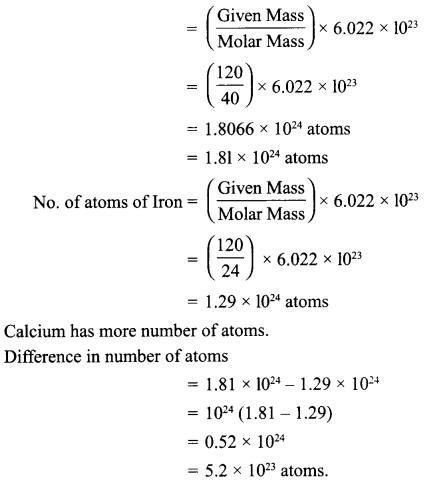
Answer 7.
Velocity: Rate of change of displacement.
Acceleration: Rate of change of velocity of a moving body.
When a body is released, its initial velocity, i.e. w = 0 but
g = 10m/s2. Hence it is possible for a body to have zero velocity but constant acceleration.
OR
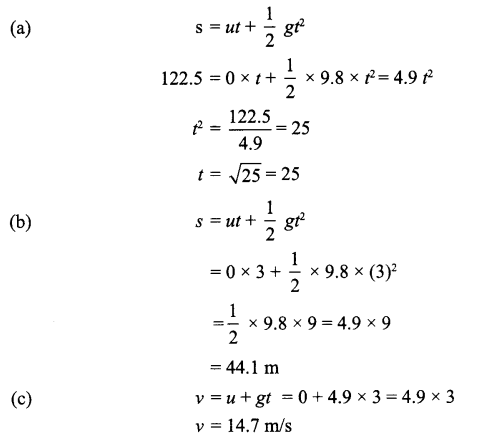
Answer 8.
- Group of organisms causing infectious diseases are:
- Virus
- Bacteria
- Fungi
- Protozoa
- Multicellular Worms
-
- Tetanus
- Polio
Answer 9.
- Higher yield
- Improved quality
- Biotic and abiotic resistance
- Change in maturity duration
- Desirable agronomic traits
- Wider adaptability of crops (or any six relevant traits)
OR
- Weeds. Example-Xanthium
- They extract the nutrients from the soil that are meant for the crop plant.
- By manual weeding or by applying weedicides.
Answer 10.
- v = 330 ms-1, t = 6 s
D = \(\frac { vt }{ 2 }\) = \((\frac { 330\times 6 }{ 2 } )\) = 990 m - Longitudinal waves will be produced.
Answer 11.
Symbiosis refers to association between two organisms which benefit mutually from each other. Lichens is a symbiotic life form composed of algae and fungi.
Answer 12.
- Energy due to the motion of a body is called kinetic energy.
K.E = \(\frac { 1 }{ 2 }\) mv2 - m = 2 Kg, t = 5 s
Velocity after 5 s (v) = 0 + 10 × 5
= 50 m/s
Therefore, K.E = \(\frac { 1 }{ 2 }\) × 2 × (50)2
= 2500 Joule = 2.5 KJ
Answer 13.
- The moving tanker completely filled with water is in the inertia of motion, both water and tanker experiences momentum. On applying sudden brakes the tanker will come to rest but the water will continue to remain in the state of motion and hence the tanker will lose the balance and topple.
- The water will fall forward.
- Abhishek shows the value of being intelligent, having scientific knowledge, helpful and caring.
Answer 14.
(a) 1 kW h = 3.6 × 106 Joules
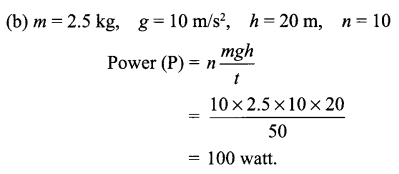
Answer 15.
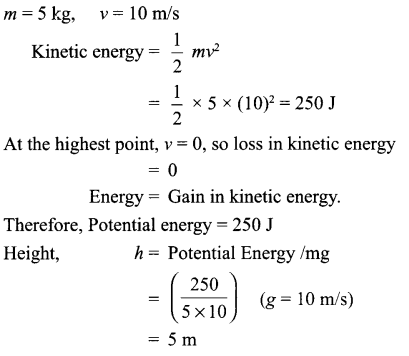
Answer 16.
Description:
Take an electric bell and an airtight glass jar. The electric bell is suspended inside the airtight glass jar, which is connected to a vacuum pump.
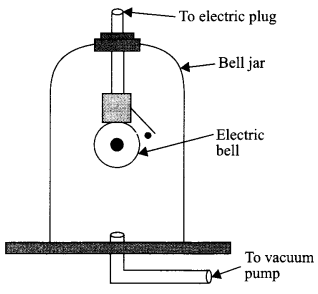
Working:
- When we press the switch, we’ll be able to hear the bell.
- When the air in the jar is pumped out gradually, the sound becomes feeble although the same amount of current is flowing through the bell.
- When the air is removed completely, we’ll not be able to hear the sound of the bell.
Conclusion:
This experiment shows that sound requires a medium for its propagation.
Answer 17.
AIDS is considered as a syndrome because the AIDS virus damages the immune system of the body and the body can no longer fight against even the minor infections. Any small health problem can become a major infection and damage the entire organ or a system. The effect of disease becomes very severe and complex, at times killing the person from AIDS. Hence there is no specific disease symptoms for AIDS, but it results in a complex diseases and ultimately leads to death.
Answer 18.
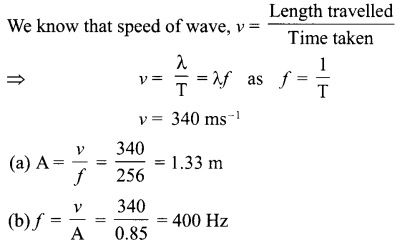
Answer 19.
(a) When a body moves in a circular path with uniform speed, its motion is called uniform circular motion.
(b) Radius = 50 m
Time = 50 s
1. The distance covered by an athlete A to B i.e., semicircle of the track
∴ Circumference = 2 πr
∴ Half-circumference = πr
= \(\frac { 22 }{ 7 }\) × 50
∴ Distance = 157.14 m
2. Displacement from A to B is diameter AB
d= 2r
∴ d= 2 × 50= 100 m
3. Speed = ?
Speed = \(\frac { Distance }{ time }\) = \(\frac { 157.14 }{ 50 }\) = 3.143
∴ Speed = 3.143 m/s
Answer 20.
(a) Rutherford’s scattering experiment
He selected very thin gold foil to be bombarded with fast moving a-particles – which were positively charged ‘He’ ions.
The fast moving a-particles have a considerable amount of K.E. to hit the gold atoms
Observations
- Most of the a-particles passed straight through the foil without any deflection.
- One out of 20,000 particles appeared to rebound.
Inference
- There is a positively centre inside the atom called nucleus.
- The electrons revolve around the nucleus in well defined orbits.
- The size of the nucleus is very small as compared to the size of the atom.
(b) Atomic number is 17
Element is chlorine
Electronic configuration – 2, 8, 7; valency – 1
OR
- Separating funnel
- Sublimation
- Evaporation/crystallisation
- Magnetic separator
- Centrifugation
Answer 21.
‘Energy possessed by object by virtue of its position or configuration’ (to be explained in candidate’s own words).
Example: Stretched string of bow/ a stone lifted to a certain height (or any other appropriate example).
S.I. unit-joule
Let an static object of mass, m be raised to a height h above the ground.
Then, Force required to raise the object = Weight of the object
= mg
Now, Work done on the object, W = Force × displacement
= mg × h
This work done is the stored potential energy of the object,
∴ P.E. = mgh
As the object falls down, m = 20 kg; g = 10 m/s2; h = 10 m
∴ P.E. = mgh = 20 kg × 10 m/s2 × 10 m
P.E. = 2000 J
Its P.E. gets converted to K.E.
Kinetic energy just before it touches = 2000 J
SECTION-B
Answer 22.
In an open container, the gaseous product, carbon dioxide will escape into the atmosphere and the observed final mass will be less than the actual final mass.
Answer 23.
Presence of chitinous covering that prevents desiccation.
Answer 24.
- The measuring cylinder should be kept on the plain flat surface.
- The lower meniscus of water and the eye level should be parallel and in straight line.
Answer 25.
‘The compound, iron sulphide reacts with dilute sulphuric acid to form hydrogen sulphide gas. This gas is a colourless gas with the smell of rotten eggs.
Answer 26.
Mass of (copper sulphate + sodium sulphide) = Mass of (copper sulphide + sodium sulphate)
15.9g + 7.8 g = 9.5 g + x
x = 23.7g
Answer 27.
The stages during the life cycle of mosquito is:
- eggs
- larva
- pupa
- adult.
We hope the CBSE Sample Papers for Class 9 Science Paper 4 help you. If you have any query regarding CBSE Sample Papers for Class 9 Science Paper 4, drop a comment below and we will get back to you at the earliest.